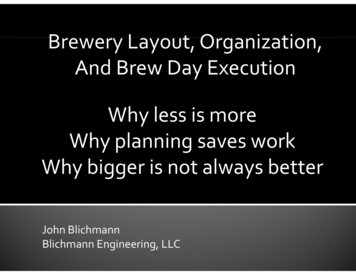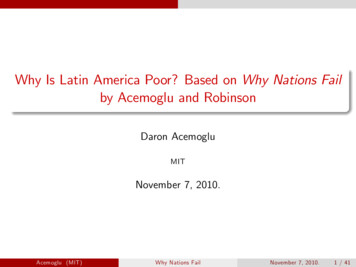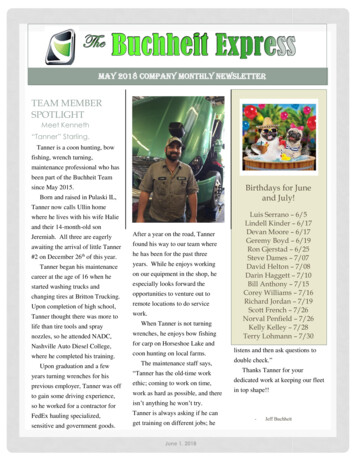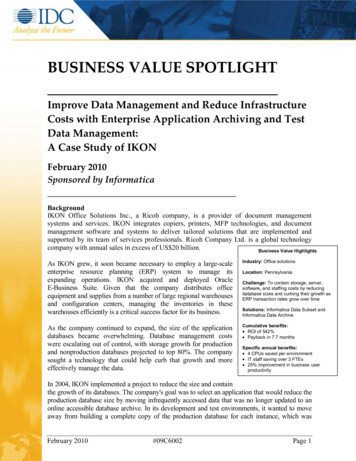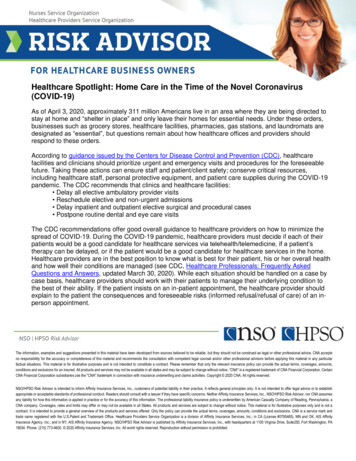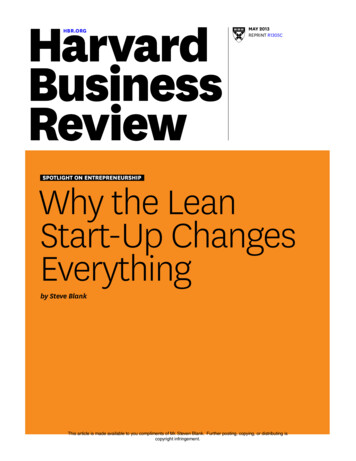
Transcription
HBR.ORGMAY 2013REPRINT R1305CSPOTLIGHT ON ENTREPRENEURSHIPWhy the LeanStart-Up ChangesEverythingby Steve BlankThis article is made available to you compliments of Mr. Steven Blank. Further posting, copying, or distributing iscopyright infringement.
SPOTLIGHT ON ENTREPRENEURSHIPSpotlightThis article is made available to you compliments of Mr. Steven Blank. Further posting, copying, or distributing iscopyright infringement.
FOR ARTICLE REPRINTS CALL 800-988-0886 OR 617-783-7500, OR VISIT HBR.ORGARTWORK Sara Hughes, Download, 2005Acrylic on linen, 1.5 m x 1.5 mWallace Trust CollectionSteve Blank is a consultingassociate professor atStanford University anda lecturer and NationalScience Foundation principalinvestigator at the Universityof California at Berkeley andColumbia University. Hehas participated in eighthigh-tech start-ups as eithera cofounder or an earlyemployee.Why theLeanStart-UpChangesEverythingby Steve BlankMay 2013 Harvard Business Review 3This article is made available to you compliments of Mr. Steven Blank. Further posting, copying, or distributing iscopyright infringement.
SPOTLIGHT ON ENTREPRENEURSHIPLaunching a new enterprise—whether it’s a tech start-up, asmall business, or an initiativewithin a large corporation—has always been a hit-or-missproposition. According to thedecades-old formula, youwrite a business plan, pitch itto investors, assemble a team,introduce a product, and startselling as hard as you can. And somewhere in thissequence of events, you’ll probably suffer a fatalsetback. The odds are not with you: As new researchby Harvard Business School’s Shikhar Ghosh shows,75% of all start-ups fail.But recently an important countervailing forcehas emerged, one that can make the process of starting a company less risky. It’s a methodology calledthe “lean start-up,” and it favors experimentationover elaborate planning, customer feedback overintuition, and iterative design over traditional “bigdesign up front” development. Although the methodology is just a few years old, its concepts—suchas “minimum viable product” and “pivoting”—havequickly taken root in the start-up world, and business schools have already begun adapting their curricula to teach them.The lean start-up movement hasn’t gone totallymainstream, however, and we have yet to feel its fullimpact. In many ways it is roughly where the big datamovement was five years ago—consisting mainly ofa buzzword that’s not yet widely understood, whoseimplications companies are just beginning to grasp.But as its practices spread, they’re turning the conventional wisdom about entrepreneurship on itshead. New ventures of all kinds are attempting toimprove their chances of success by following itsprinciples of failing fast and continually learning.And despite the methodology’s name, in the longterm some of its biggest payoffs may be gained by thelarge companies that embrace it.In this article I’ll offer a brief overview of leanstart-up techniques and how they’ve evolved. Mostimportant, I’ll explain how, in combination withother business trends, they could ignite a new entrepreneurial economy.The businessmodel canvas letsyou look at all ninebuilding blocks ofyour business onone page. Eachcomponent of thebusiness modelcontains a seriesof hypotheses thatyou need to test.KEY PARTNERSKEY ACTIVITIESVALUE PROPOSITIONSWho are our key partners?Who are our keysuppliers?Which key resources arewe acquiring from ourpartners?Which key activities dopartners perform?What key activities do ourvalue propositions require?Our distribution channels?Customer relationships?Revenue streams?What value do we deliver to thecustomer?Which one of our customers’problems are we helping tosolve?What bundles of products andservices are we offering to eachsegment?Which customer needs are wesatisfying?What is the minimum viableproduct?KEY RESOURCESWhat key resources do ourvalue propositions require?Our distribution channels?Customer relationships?Revenue streams?CUSTOMERRELATIONSHIPSCUSTOMERSEGMENTSHow do we get, keep, and growcustomers?Which customer relationshipshave we established?How are they integrated withthe rest of our business model?How costly are they?For whom are wecreating value?Who are our mostimportant customers?What are the customerarchetypes?CHANNELSThrough which channels do ourcustomer segments want to bereached?How do other companies reachthem now?Which ones work best?Which ones are mostcost-efficient?How are we integrating themwith customer routines?COST STRUCTUREREVENUE STREAMSWhat are the most important costs inherent to our business model?Which key resources are most expensive?Which key activities are most expensive?For what value are our customers really willing to pay?For what do they currently pay?What is the revenue model?What are the pricing tactics?SOURCE WWW.BUSINESSMODELGENERATION.COM/CANVAS. CANVAS CONCEPT DEVELOPED BY ALEXANDER OSTERWALDER AND YVES PIGNEUR.COPYRIGHT 2013 HARVARD BUSINESS SCHOOL PUBLISHING CORPORATION. ALL RIGHTS RESERVED.4 Harvard Business Review May 2013This article is made available to you compliments of Mr. Steven Blank. Further posting, copying, or distributing iscopyright infringement.PHOTOGRAPHY PREVIOUS PAGE: COURTESY OF THE ARTIST AND THE WALLACE TRUSTSketch Out Your Hypotheses
FOR ARTICLE REPRINTS CALL 800-988-0886 OR 617-783-7500, OR VISIT HBR.ORGIdea in BriefOver the past few years,a new methodologyfor launching companies, called the “leanstart-up,” has begun toreplace the old regimen.PHOTOGRAPHY: SARA HUGHES WITH HER WORK, COLOUR CODES, 2011, GOW LANGSFORD GALLERY, AUCKLAND, NEW ZEALANDThe Fallacy of thePerfect Business PlanInstead of executing business plans, operating in stealthmode, and releasing fully functional prototypes, young ventures are testing hypotheses,gathering early and frequentcustomer feedback, and showing “minimum viable products”to prospects. This new processrecognizes that searching for abusiness model (which is theprimary task facing a start-According to conventional wisdom, the first thingevery founder must do is create a business plan—astatic document that describes the size of an opportunity, the problem to be solved, and the solution thatthe new venture will provide. Typically it includes afive-year forecast for income, profits, and cash flow.A business plan is essentially a research exercise written in isolation at a desk before an entrepreneur haseven begun to build a product. The assumption isthat it’s possible to figure out most of the unknownsof a business in advance, before you raise money andactually execute the idea.Once an entrepreneur with a convincing businessplan obtains money from investors, he or she beginsdeveloping the product in a similarly insular fashion.Developers invest thousands of man-hours to get itready for launch, with little if any customer input.Only after building and launching the product doesthe venture get substantial feedback from customers—when the sales force attempts to sell it. And toooften, after months or even years of development,entrepreneurs learn the hard way that customers donot need or want most of the product’s features.After decades of watching thousands of start-upsfollow this standard regimen, we’ve now learned atleast three things:1. Business plans rarely survive first contact withcustomers. As the boxer Mike Tyson once said abouthis opponents’ prefight strategies: “Everybody has aplan until they get punched in the mouth.”2. No one besides venture capitalists and the lateSoviet Union requires five-year plans to forecastcomplete unknowns. These plans are generally fiction, and dreaming them up is almost always a wasteof time.3. Start-ups are not smaller versions of large companies. They do not unfold in accordance with mas-up) is entirely different fromexecuting against that model(which is what establishedfirms do).Recently, business schoolshave begun to teach themethodology, which can alsobe learned at events such asStartup Weekend. Over time,lean start-up techniques couldreduce the failure rate of newventures and, in combinationwith other trends taking holdin the business world, launcha new, more entrepreneurialeconomy.ter plans. The ones that ultimately succeed go quicklyfrom failure to failure, all the while adapting, iterating on, and improving their initial ideas as they continually learn from customers.One of the critical differences is that while existing companies execute a business model, start-upslook for one. This distinction is at the heart of thelean start-up approach. It shapes the lean definitionof a start-up: a temporary organization designed tosearch for a repeatable and scalable business model.The lean method has three key principles:First, rather than engaging in months of planningand research, entrepreneurs accept that all they haveon day one is a series of untested hypotheses—basically, good guesses. So instead of writing an intricatebusiness plan, founders summarize their hypothesesin a framework called a business model canvas. Essentially, this is a diagram of how a company createsvalue for itself and its customers. (See the exhibit“Sketch Out Your Hypotheses.”)Second, lean start-ups use a “get out of the building” approach called customer development to testtheir hypotheses. They go out and ask potential users, purchasers, and partners for feedback on all elements of the business model, including product features, pricing, distribution channels, and affordablecustomer acquisition strategies. The emphasis is onnimbleness and speed: New ventures rapidly assemble minimum viable products and immediately elicitcustomer feedback. Then, using customers’ input torevise their assumptions, they start the cycle overagain, testing redesigned offerings and making further small adjustments (iterations) or more substantive ones (pivots) to ideas that aren’t working. (Seethe exhibit “Listen to Customers.”)Third, lean start-ups practice something calledagile development, which originated in the softwareindustry. Agile development works hand-in-handwith customer development. Unlike typical year-May 2013 Harvard Business Review 5This article is made available to you compliments of Mr. Steven Blank. Further posting, copying, or distributing iscopyright infringement.
SPOTLIGHT ON ENTREPRENEURSHIPtype. Nine months later the start-up had obtainedmore than 3 million in venture funding. The teamexpected to have a commercial product ready justnine months after that.long product development cycles that presupposeknowledge of customers’ problems and productneeds, agile development eliminates wasted timeand resources by developing the product iterativelyand incrementally. It’s the process by which startups create the minimum viable products they test.(See the exhibit “Quick, Responsive Development.”)When Jorge Heraud and Lee Redden startedBlue River Technology, they were students in myclass at Stanford. They had a vision of building robotic lawn mowers for commercial spaces. Aftertalking to over 100 customers in 10 weeks, theylearned their initial customer target—golf courses—didn’t value their solution. But then they began totalk to farmers and found a huge demand for anautomated way to kill weeds without chemicals.Filling it became their new product focus, and within10 weeks Blue River had built and tested a proto-Stealth Mode’s Declining PopularityListen to CustomersDuring customer development, a start-up searches for a business model that works. If customer feedback reveals that itsbusiness hypotheses are wrong, it either revises them or “pivots” to new hypotheses. Once a model is proven, the start-upstarts executing, building a formal organization. Each stage ofcustomer development is iterative: A start-up will probably failseveral times before finding the right ERVALIDATIONCUSTOMERCREATIONStart-up continuesto test all otherhypotheses andtries to validatecustomers’ interest through earlyorders or productusage. If there’s nointerest, the startup can “pivot” bychanging one ormore hypotheses.The product isrefined enoughto sell. Usingits provenhypotheses, thestart-up buildsdemand by rapidly ramping upmarketing andsales spending,and scales upthe business.4COMPANYBUILDINGPIVOT1Founders translatecompany ideasinto businessmodel hypotheses,test assumptionsabout customers’needs, and thencreate a “minimumviable product”to try out theirproposed solutionon customers.234Business transitions from startup mode, witha customer development teamsearching foranswers, to functional departments executingits model.Lean methods are changing the language start-upsuse to describe their work. During the dot-comboom, start-ups often operated in “stealth mode”(to avoid alerting potential competitors to a marketopportunity), exposing prototypes to customersonly during highly orchestrated “beta” tests. Thelean start-up methodology makes those conceptsobsolete because it holds that in most industriescustomer feedback matters more than secrecy andthat constant feedback yields better results than cadenced unveilings.Those two fundamental precepts crystallized forme during my career as an entrepreneur. (I’ve beeninvolved with eight high-tech start-ups, as either afounder or an early employee.) When I shifted intoteaching, a decade ago, I came up with the formulafor customer development described earlier. By2003 I was outlining this process in a course at theHaas School of Business at the University of California at Berkeley.In 2004, I invested in a start-up founded by EricRies and Will Harvey and, as a condition of my investment, insisted that they take my course. Ericquickly recognized that waterfall development, thetech industry’s traditional, linear product development approach, should be replaced by iterative agiletechniques. He also saw similarities between thisemerging set of start-up disciplines and the ToyotaProduction System, which had become known as“lean manufacturing.” Eric dubbed the combinationof customer development and agile practices the“lean start-up.”The tools were popularized by a series of successful books. In 2003, I wrote The Four Steps to theEpiphany, articulating for the first time that startups were not smaller versions of large companiesand laying out the customer development processin detail. In 2010, Alexander Osterwalder and YvesPigneur gave entrepreneurs the standard framework for business model canvases in Business ModelGeneration. In 2011 Eric published an overview inThe Lean Startup. And in 2012 Bob Dorf and I summarized what we’d learned about lean techniques ina step-by-step handbook called The Startup Owner’sManual.6 Harvard Business Review May 2013This article is made available to you compliments of Mr. Steven Blank. Further posting, copying, or distributing iscopyright infringement.
FOR ARTICLE REPRINTS CALL 800-988-0886 OR 617-783-7500, OR VISIT HBR.ORGWhat Lean Start-Ups Do DifferentlyThe lean start-up method is now being taughtat more than 25 universities and through a popularonline course at Udacity.com. In addition, in almostevery city around world, you’ll find organizationslike Startup Weekend introducing the lean methodto hundreds of prospective entrepreneurs at a time.At such gatherings a roomful of start-up teams cancycle through half a dozen potential product ideasin a matter of hours. Although it sounds incredibleto people who haven’t been to one, at these eventssome businesses are formed on a Friday evening andare generating actual revenue by Sunday afternoon.Creating an Entrepreneurial,Innovation-Based EconomyWhile some adherents claim that the lean processcan make individual start-ups more successful, Ibelieve that claim is too grandiose. Success is predicated on too many factors for one methodology toguarantee that any single start-up will be a winner.But on the basis of what I’ve seen at hundreds ofstart-ups, at programs that teach lean principles, andat established companies that practice them, I canmake a more important claim: Using lean methodsacross a portfolio of start-ups will result in fewer failures than using traditional methods.A lower start-up failure rate could have profoundeconomic consequences. Today the forces of disruption, globalization, and regulation are buffeting theeconomies of every country. Established industriesare rapidly shedding jobs, many of which will neverreturn. Employment growth in the 21st century willhave to come from new ventures, so we all have avested interest in fostering an environment thathelps them succeed, grow, and hire more workers.The creation of an innovation economy that’s drivenby the rapid expansion of start-ups has never beenmore imperative.In the past, growth in the number of start-upswas constrained by five factors in addition to thefailure rate:1. The high cost of getting the first customer andthe even higher cost of getting the product wrong.2. Long technology development cycles.3. The limited number of people with an appetite for the risks inherent in founding or working ata start-up.4. The structure of the venture capital industry, inwhich a small number of firms each needed to investbig sums in a handful of start-ups to have a chance atsignificant returns.The founders of lean start-ups don’t begin with a business plan;they begin with the search for a business model. Only afterquick rounds of experimentation and feedback reveal a modelthat works do lean founders focus on execution.LeanTraditionalStrategyBusiness ModelHypothesis-drivenBusiness PlanImplementation-drivenNew-Product ProcessCustomer DevelopmentGet out of the office and test hypothesesProduct ManagementPrepare offering for market following alinear, step-by-step planEngineeringAgile DevelopmentBuild the product iteratively andincrementallyAgile or Waterfall DevelopmentBuild the product iteratively, or fullyspecify the product before building itOrganizationCustomer and Agile Development TeamsHire for learning, nimbleness, and speedDepartments by FunctionHire for experience and ability to executeFinancial ReportingMetrics That MatterCustomer acquisition cost, lifetimecustomer value, churn, viralnessAccountingIncome statement, balance sheet, cashflow statementFailureExpectedFix by iterating on ideas and pivoting awayfrom ones that don’t workExceptionFix by firing executivesSpeedRapidOperates on good-enough dataMeasuredOperates on complete data5. The concentration of real expertise in howto build start-ups, which in the United States wasmostly found in pockets on the East and West coasts.(This is less an issue in Europe and other parts of theworld, but even overseas there are geographic entrepreneurial hot spots.)The lean approach reduces the first two constraints by helping new ventures launch productsthat customers actually want, far more quickly andcheaply than traditional methods, and the third bymaking start-ups less risky. And it has emerged ata time when other business and technology trendsare likewise breaking down the barriers to start-upformation. The combination of all these forces is altering the entrepreneurial landscape.May 2013 Harvard Business Review 7This article is made available to you compliments of Mr. Steven Blank. Further posting, copying, or distributing iscopyright infringement.
SPOTLIGHT ON ENTREPRENEURSHIPToday open source software, like GitHub, andcloud services, such as Amazon Web Services, haveslashed the cost of software development from millions of dollars to thousands. Hardware start-ups nolonger have to build their own factories, since offshore manufacturers are so easily accessible. Indeed,it’s become quite common to see young tech companies that practice the lean start-up methodologyoffer software products that are simply “bits” delivered over the web or hardware that’s built in Chinawithin weeks of being formed. Consider Roominate,a start-up designed to inspire girls’ confidence andinterest in science, technology, engineering, andmath. Once its founders had finished testing anditerating on the design of their wired dollhouse kit,Street small businesses that make up the bulk of theeconomy. If the entire universe of small businessembraced them, I strongly suspect it would increasegrowth and efficiency, and have a direct and immediate impact on GDP and employment.There are signs that this may in fact happen. In2011 the U.S. National Science Foundation beganusing lean methods to commercialize basic scienceresearch in a program called the Innovation Corps.Eleven universities now teach the methods to hundreds of teams of senior research scientists across theUnited States.MBA programs are adopting these techniques,too. For years they taught students to apply largecompany approaches—such as accounting methodsLean start-up practices aren’t just for youngtech ventures. Large companies, such as GE andIntuit, have begun to implement them.they sent the specs off to a contract manufacturer inChina. Three weeks later the first products arrived.Another important trend is the decentralizationof access to financing. Venture capital used to bea tight club of formal firms clustered near SiliconValley, Boston, and New York. In today’s entrepreneurial ecosystem, new super angel funds, smallerthan the traditional hundred-million-dollar-sizedVC fund, can make early-stage investments. Worldwide, hundreds of accelerators, like Y Combinatorand TechStars, have begun to formalize seed investments. And crowdsourcing sites like Kickstarter provide another, more democratic method of financingstart-ups.The instantaneous availability of information isalso a boon to today’s new ventures. Before the internet, new company founders got advice only asoften as they could have coffee with experiencedinvestors or entrepreneurs. Today the biggest challenge is sorting through the overwhelming amountof start-up advice they get. The lean concepts provide a framework that helps you differentiate thegood from the bad.Lean start-up techniques were initially designedto create fast-growing tech ventures. But I believethe concepts are equally valid for creating the Mainfor tracking revenue and cash flow, and organizational theories about managing—to start-ups. Yetstart-ups face completely different issues. Now business schools are realizing that new ventures needtheir own management tools.As business schools embrace the distinction between management execution and searching for abusiness model, they’re abandoning the businessplan as the template for entrepreneurial education.And the business plan competitions that have beena celebrated part of the MBA experience for over adecade are being replaced by business model competitions. (Harvard Business School became the latest to make this switch, in 2012.) Stanford, Harvard,Berkeley, and Columbia are leading the charge andembracing the lean start-up curriculum. My LeanLaunchPad course for educators is now training over250 college and university instructors a year.A New Strategy for the21st-Century CorporationIt’s already becoming clear that lean start-up practices are not just for young tech ventures.Corporations have spent the past 20 years increasing their efficiency by driving down costs. Butsimply focusing on improving existing business8 Harvard Business Review May 2013This article is made available to you compliments of Mr. Steven Blank. Further posting, copying, or distributing iscopyright infringement.
FOR ARTICLE REPRINTS CALL 800-988-0886 OR 617-783-7500, OR VISIT HBR.ORGQuick, Responsive DevelopmentIn contrast to traditional product development, in which eachstage occurs in linear order and lasts for months, agile development builds products in short, repeated cycles. A start-upproduces a “minimum viable product”—containing only critical features—gathers feedback on it from customers, and thenstarts over with a revised minimum viable S & IMUMVIABLE PRODUCTCUSTOMER FEEDBACKPLANNINGANALYSIS & IMUMVIABLE PRODUCTCUSTOMER FEEDBACKPLANNINGANALYSIS & IMUMVIABLE PRODUCTmodels is not enough anymore. Almost every largecompany understands that it also needs to deal withever-increasing external threats by continually innovating. To ensure their survival and growth, corporations need to keep inventing new business models.This challenge requires entirely new organizationalstructures and skills.Over the years managerial experts such as Clayton Christensen, Rita McGrath, Vijay Govindarajan,Henry Chesbrough, Ian MacMillan, Alexander Os-terwalder, and Eric von Hippel have advanced thethinking on how large companies can improve theirinnovation processes. During the past three years,however, we have seen large companies, includingGeneral Electric, Qualcomm, and Intuit, begin toimplement the lean start-up methodology.GE’s Energy Storage division, for instance, is using the approach to transform the way it innovates.In 2010 Prescott Logan, the general manager of thedivision, recognized that a new battery developedby the unit had the potential to disrupt the industry. Instead of preparing to build a factory, scale upproduction, and launch the new offering (ultimatelynamed Durathon) as a traditional product extension,Logan applied lean techniques. He started searching for a business model and engaging in customerdiscovery. He and his team met face-to-face withdozens of global prospects to explore potential newmarkets and applications. These weren’t sales calls:The team members left their PowerPoint slides behind and listened to customers’ issues and frustrations with the battery status quo. They dug deepto learn how customers bought industrial batteries,how often they used them, and the operating conditions. With this feedback, they made a major shift intheir customer focus. They eliminated one of theirinitial target segments, data centers, and discovereda new one—utilities. In addition, they narrowed thebroad customer segment of “telecom” to cell phoneproviders in developing countries with unreliableelectric grids. Eventually GE invested 100 millionto build a world-class battery manufacturing facilityin Schenectady, New York, which it opened in 2012.According to press reports, demand for the new batteries is so high that GE is already running a backlogof orders.THE FIRST HUNDRED YEARS of management education focused on building strategies and tools thatformalized execution and efficiency for existingbusinesses. Now, we have the first set of tools forsearching for new business models as we launchstart-up ventures. It also happens to have arrivedjust in time to help existing companies deal with theforces of continual disruption. In the 21st centurythose forces will make people in every kind of organization—start-ups, small businesses, corporations,and government—feel the pressure of rapid change.The lean start-up approach will help them meet ithead-on, innovate rapidly, and transform businessas we know it.HBR Reprint R1305CMay 2013 Harvard Business Review 9This article is made available to you compliments of Mr. Steven Blank. Further posting, copying, or distributing iscopyright infringement.
Startup Weekend. Over time, lean start-up techniques could reduce the failure rate of new ventures and, in combination with other trends taking hold in the business world, launch a new, more entrepreneurial economy. ter plans. The ones that ultimately succeed go quickly

